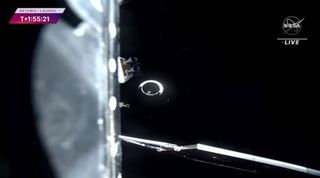
NASA's Artemis 1 mission is officially on its way to the moon.
Artemis 1 launched early Wednesday morning (Nov. 16), sending an uncrewed Orion capsule aloft atop the agency's huge Space Launch System (SLS) rocket.
The SLS' core stage and twin solid rocket boosters got the Orion spacecraft to Earth orbit, but the capsule needed another push to break free of our planet's gravity and head for the moon. And it got that push, thanks to a long engine burn from the SLS upper stage, called the Interim Cryogenic Propulsion Stage (ICPS).
The ICPS' single engine kicked on about 87 minutes after the Artemis 1 mission liftoff and burned for 18 minutes, boosting Orion's speed from 17,500 mph (28,160 kph) to 22,500 mph (36,210 kph) as planned and setting the capsule on course for the moon.
"Trans-lunar injection burn complete! @NASA_Orion is on its way to the moon! Thanks to ICPS, @NASA_SLS's upper stage, for the push to get us on our way," Jim Free, associate administrator of the Exploration Systems Development Mission Directorate at NASA headquarters in Washington, said via Twitter just after the burn ended.
Related: NASA's Artemis 1 moon mission: Live updates
More: 10 wild facts about the Artemis 1 moon mission
Trans-lunar injection burn complete! @NASA_Orion is on its way to the Moon! Thanks to ICPS, @NASA_SLS's upper stage, for the push to get us on our way.November 16, 2022
Another big milestone came shortly thereafter, about 115 minutes into the flight: Orion separated from the ICPS. The capsule and its European-built service module will now make their own way to lunar orbit, while the ICPS will deploy 10 ride-along cubesats over the next couple of hours.
Get the Space.com Newsletter
Breaking space news, the latest updates on rocket launches, skywatching events and more!
Orion's journey will take about six days. The capsule will then spend about 10 days in lunar orbit before heading back home to Earth. Orion will barrel into our atmosphere at about 25,000 mph (40,000 kph) on Dec. 11, giving its heat shield a stern test, and then splash down under parachutes in the Pacific Ocean off the coast of California.
Artemis 1 is a shakeout cruise designed to demonstrate that SLS and Orion are ready for astronaut missions. If everything goes well, Artemis 2 will launch a crew around the moon in 2024 and Artemis 3 will put boots down near the moon's south pole a year or so later.
The Artemis program won't be done at that point, however; it aims to establish a crewed outpost near the lunar south pole and set up a small moon-orbiting space station called Gateway as well.
NASA plans to use the lessons learned during the buildout of this infrastructure to help send astronauts to Mars, which the agency hopes to do in the late 2030s or early 2040s.
Mike Wall is the author of "Out There" (Grand Central Publishing, 2018; illustrated by Karl Tate), a book about the search for alien life. Follow him on Twitter @michaeldwall. Follow us on Twitter @Spacedotcom or on Facebook.
Join our Space Forums to keep talking space on the latest missions, night sky and more! And if you have a news tip, correction or comment, let us know at: community@space.com.

Michael Wall is a Senior Space Writer with Space.com and joined the team in 2010. He primarily covers exoplanets, spaceflight and military space, but has been known to dabble in the space art beat. His book about the search for alien life, "Out There," was published on Nov. 13, 2018. Before becoming a science writer, Michael worked as a herpetologist and wildlife biologist. He has a Ph.D. in evolutionary biology from the University of Sydney, Australia, a bachelor's degree from the University of Arizona, and a graduate certificate in science writing from the University of California, Santa Cruz. To find out what his latest project is, you can follow Michael on Twitter.
